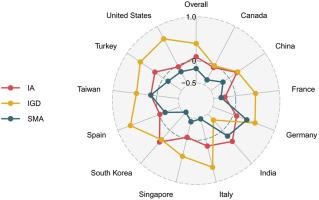当前位置:
X-MOL 学术
›
Comput. Hum. Behav.
›
论文详情
Our official English website, www.x-mol.net, welcomes your
feedback! (Note: you will need to create a separate account there.)
Do men become addicted to internet gaming and women to social media? A meta-analysis examining gender-related differences in specific internet addiction
Computers in Human Behavior ( IF 9.0 ) Pub Date : 2020-12-01 , DOI: 10.1016/j.chb.2020.106480 Wenliang Su , Xiaoli Han , Hanlu Yu , Yiling Wu , Marc N. Potenza
Computers in Human Behavior ( IF 9.0 ) Pub Date : 2020-12-01 , DOI: 10.1016/j.chb.2020.106480 Wenliang Su , Xiaoli Han , Hanlu Yu , Yiling Wu , Marc N. Potenza

|
Abstract Males have been proposed to be more vulnerable to internet addiction (IA) than females. However, males and females may differ with respect to specific patterns and types of internet usage and related IA. To investigate further, a meta-analysis was conducted to investigate gender-related differences in internet gaming disorder (IGD) and social media addiction (SMA). The current meta-analysis aimed to quantify gender-related effect sizes relating to IGD and SMA, examine potential moderating influences of regions and other possible confounds, and compare the findings with generalized IA at the country level. The meta-analysis comprised 53 effect sizes with 82,440 individuals from 21 countries/regions for IGD, and 41 effect sizes with 58,336 individuals from 22 countries/regions for SMA. A random-effects model confirmed important gender-specific distinctions as men were more likely to exhibit IGD than women (g = 0.479) and less likely to exhibit SMA than women (g = −0.202). Additional moderator analyses revealed that effect sizes of IGD and SMA were larger in Europe and the Americas than in Asia. Further analyses indicated that the effect sizes of gender-related differences in IGD and SMA at the country-level were significantly larger than those in generalized IA, which suggests that gender-related differences in specific IAs may be underestimated in the “umbrella” of generalized IA. Results have implications for explaining why males and females may become addicted to internet use through different pathways.
中文翻译:

男人会沉迷于网络游戏而女人会沉迷于社交媒体吗?一项荟萃分析检查特定网络成瘾的性别相关差异
摘要 男性比女性更容易受到网络成瘾 (IA) 的影响。但是,男性和女性在互联网使用和相关 IA 的特定模式和类型方面可能有所不同。为了进一步调查,进行了一项荟萃分析来调查网络游戏障碍 (IGD) 和社交媒体成瘾 (SMA) 的性别相关差异。当前的荟萃分析旨在量化与 IGD 和 SMA 相关的性别相关效应大小,检查区域和其他可能混淆的潜在调节影响,并将结果与国家层面的广义 IA 进行比较。荟萃分析包括来自 21 个国家/地区的 82,440 个人的 53 个 IGD 效应量和 41 个效应量和来自 22 个国家/地区的 58,336 个人的 SMA。随机效应模型证实了重要的性别差异,因为男性比女性更有可能表现出 IGD (g = 0.479),并且比女性更不可能表现出 SMA (g = -0.202)。额外的调节器分析显示,IGD 和 SMA 在欧洲和美洲的效果比在亚洲更大。进一步的分析表明,国家层面IGD和SMA性别相关差异的影响大小显着大于广义IA中的影响大小,这表明在广义IA的“伞”中可能低估了特定IA中的性别相关差异。 IA。结果对解释为什么男性和女性可能通过不同途径对互联网使用上瘾有一定意义。479) 并且比女性更不可能表现出 SMA (g = -0.202)。额外的调节器分析显示,IGD 和 SMA 在欧洲和美洲的效果比在亚洲更大。进一步的分析表明,国家层面IGD和SMA性别相关差异的影响大小显着大于广义IA中的影响大小,这表明在广义IA的“伞”中可能低估了特定IA中的性别相关差异。 IA。结果对解释为什么男性和女性可能通过不同途径对互联网使用上瘾有一定意义。479) 并且比女性更不可能表现出 SMA (g = -0.202)。额外的调节器分析显示,IGD 和 SMA 在欧洲和美洲的效果比在亚洲更大。进一步的分析表明,国家层面IGD和SMA性别相关差异的影响大小显着大于广义IA中的影响大小,这表明在广义IA的“伞”中可能低估了特定IA中的性别相关差异。 IA。结果对解释为什么男性和女性可能通过不同途径对互联网使用上瘾有一定意义。进一步的分析表明,国家层面IGD和SMA性别相关差异的影响大小显着大于广义IA中的影响大小,这表明在广义IA的“伞”中可能低估了特定IA中的性别相关差异。 IA。结果对解释为什么男性和女性可能通过不同途径对互联网使用上瘾有一定意义。进一步的分析表明,国家层面IGD和SMA性别相关差异的影响大小显着大于广义IA中的影响大小,这表明在广义IA的“伞”中可能低估了特定IA中的性别相关差异。 IA。结果对解释为什么男性和女性可能通过不同途径对互联网使用上瘾有一定意义。
更新日期:2020-12-01
中文翻译:

男人会沉迷于网络游戏而女人会沉迷于社交媒体吗?一项荟萃分析检查特定网络成瘾的性别相关差异
摘要 男性比女性更容易受到网络成瘾 (IA) 的影响。但是,男性和女性在互联网使用和相关 IA 的特定模式和类型方面可能有所不同。为了进一步调查,进行了一项荟萃分析来调查网络游戏障碍 (IGD) 和社交媒体成瘾 (SMA) 的性别相关差异。当前的荟萃分析旨在量化与 IGD 和 SMA 相关的性别相关效应大小,检查区域和其他可能混淆的潜在调节影响,并将结果与国家层面的广义 IA 进行比较。荟萃分析包括来自 21 个国家/地区的 82,440 个人的 53 个 IGD 效应量和 41 个效应量和来自 22 个国家/地区的 58,336 个人的 SMA。随机效应模型证实了重要的性别差异,因为男性比女性更有可能表现出 IGD (g = 0.479),并且比女性更不可能表现出 SMA (g = -0.202)。额外的调节器分析显示,IGD 和 SMA 在欧洲和美洲的效果比在亚洲更大。进一步的分析表明,国家层面IGD和SMA性别相关差异的影响大小显着大于广义IA中的影响大小,这表明在广义IA的“伞”中可能低估了特定IA中的性别相关差异。 IA。结果对解释为什么男性和女性可能通过不同途径对互联网使用上瘾有一定意义。479) 并且比女性更不可能表现出 SMA (g = -0.202)。额外的调节器分析显示,IGD 和 SMA 在欧洲和美洲的效果比在亚洲更大。进一步的分析表明,国家层面IGD和SMA性别相关差异的影响大小显着大于广义IA中的影响大小,这表明在广义IA的“伞”中可能低估了特定IA中的性别相关差异。 IA。结果对解释为什么男性和女性可能通过不同途径对互联网使用上瘾有一定意义。479) 并且比女性更不可能表现出 SMA (g = -0.202)。额外的调节器分析显示,IGD 和 SMA 在欧洲和美洲的效果比在亚洲更大。进一步的分析表明,国家层面IGD和SMA性别相关差异的影响大小显着大于广义IA中的影响大小,这表明在广义IA的“伞”中可能低估了特定IA中的性别相关差异。 IA。结果对解释为什么男性和女性可能通过不同途径对互联网使用上瘾有一定意义。进一步的分析表明,国家层面IGD和SMA性别相关差异的影响大小显着大于广义IA中的影响大小,这表明在广义IA的“伞”中可能低估了特定IA中的性别相关差异。 IA。结果对解释为什么男性和女性可能通过不同途径对互联网使用上瘾有一定意义。进一步的分析表明,国家层面IGD和SMA性别相关差异的影响大小显着大于广义IA中的影响大小,这表明在广义IA的“伞”中可能低估了特定IA中的性别相关差异。 IA。结果对解释为什么男性和女性可能通过不同途径对互联网使用上瘾有一定意义。











































 京公网安备 11010802027423号
京公网安备 11010802027423号